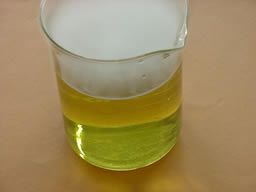Gases
Gases play a very important part in our daily lives. If you look carefully you can spot a range of gases as you walk through a shopping centre or down the road. Since most gases are colourless, their presence is not immediately obvious but you can see their effects or their containers. Air is one gaseous mixture we all come into contact with. An average school classroom contains, approximately, 300m3 or roughly 300kg of air.
One of the most common gases used is carbon dioxide. Carbon dioxide is used in cooking, carbonated drinks, fire extinquishers and to create special effects.
Click to see a 120kb video

Fermentation is a natural process carried out by micro-organisms such as yeast. Yeast break down sugar in the absence of oxygen to produce alcohol and carbon dioxide. The reaction is as follows. C6H12O6 => 2C2H6O + 2CO2.
The carbon dioxide is the desired product in cooking or bread making. As the dough heats up the carbon dioxide trapped inside the dough expands creating large gas filled spaces which give the bread soft texture.
